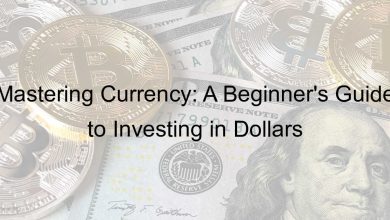Mastering Currency: A Comprehensive Guide on How to Invest in Dollars Wisely

In today’s dynamic financial landscape, the quest for secure and fruitful investment opportunities often leads individuals to consider various currency options. Among these, the US dollar stands out due to its stability and global acceptance. Understanding how to invest in dollars wisely is crucial for anyone looking to diversify their portfolio and safeguard their assets. This comprehensive guide aims to provide actionable insights and practical tips, enabling you to navigate the complexities of dollar investments while making informed decisions that align with your financial goals. Whether you are a seasoned investor or just beginning your journey, the right strategies can make all the difference.

Understanding the Dollar: Key Factors Influencing Its Value
The value of the US dollar is a multifaceted issue influenced by various factors that can bewilder even the most seasoned economists. Understanding these elements can shed light on the complexities of the global economy.
Key Influencing Factors
- Supply and Demand: The dollar’s value fluctuates based on market demand. When demand is high, the value tends to increase, and vice versa.
- Interest Rates: Central banks, particularly the Federal Reserve, play a pivotal role. Higher interest rates generally attract foreign capital, raising the dollar’s value.
- Economic Indicators: GDP growth, unemployment rates, and inflation figures significantly impact perceptions of the dollar’s strength. Strong economic performance tends to boost confidence in the dollar.
However, factors like geopolitical events and market speculation can further complicate this picture. For example, political stability often enhances trust in the dollar, whereas uncertainty can lead to depreciation. As a result, the dollar’s value remains a dynamic subject, reflecting both current events and historical trends.
Ultimately, grasping the intricacies of how these elements interplay offers valuable insights into the broader financial landscape. Understanding the dollar isn’t merely about numbers; it’s about recognizing the stories that shape our economic reality.

Effective Strategies for Investing in US Dollars: A Step-by-Step Guide
Investing in US dollars can feel like navigating a labyrinth. However, with a clear strategy, you can emerge successful. The first thing to remember is the importance of market research. Understanding economic indicators like inflation and interest rates is crucial. These factors can give you insight into the dollar’s strength and its potential fluctuations.
Diversification is Key
Next, consider diversification. Putting all your eggs in one basket can be risky. Invest in various assets, such as stocks, bonds, or even foreign currencies. This way, if one area falters, others may compensate, offering a buffer against losses. Additionally, think about timing your investments wisely. Analyze market trends; sometimes, less is more, and a cautious approach can yield better results.
Stay Informed and Adjust
Finally, don’t forget to stay informed. The financial landscape changes rapidly. Regularly reviewing your portfolio can help you make necessary adjustments. While it’s easy to get overwhelmed, patience and informed decision-making are your greatest allies in this journey.
Risk Management in Dollar Investments: Balancing Safety with Profit
Investing in dollars can feel like navigating a turbulent sea. It’s essential to understand that risk management plays a pivotal role in ensuring your financial journey remains steady. Many people dive in without a solid strategy, often leading to unexpected pitfalls. Therefore, establishing a robust risk management framework can be the difference between successful investing and significant losses.
First, diversifying your portfolio is crucial. By spreading investments across various assets, you not only mitigate risk but also enhance potential returns. Remember, focusing solely on high-risk investments may yield immediate gains, but the long-term consequences can be dire.
Understanding Your Risk Tolerance
Additionally, understanding your risk tolerance is vital. Everyone’s comfort level varies. Some investors can endure fluctuations, while others prefer the safety of more stable options. Balancing these emotional and financial aspects leads to more informed decisions.
Lastly, staying informed about market trends and geopolitical factors can significantly influence your strategies. Being proactive in adjusting your investments may help safeguard your assets. Ultimately, blending safety with profit requires a thoughtful approach, one that can sometimes be overwhelming but is well worth the effort.
Diversification: How to Incorporate Dollars into Your Investment Portfolio
Diversification is a fundamental principle in investment strategy. It helps mitigate risks while enhancing potential returns. However, incorporating dollars into your portfolio requires careful consideration. Some may wonder how to effectively blend this currency into various asset classes.
Steps to Incorporate Dollars
- Assess Your Goals: Understand your financial objectives. Are you looking for growth, stability, or income? This clarity guides your investment choices.
- Analyze Market Trends: Stay informed about global economic indicators. Currency fluctuations can impact the value of investments, so timing is crucial.
- Consider Asset Allocation: Determine the right mix of equities, bonds, or real estate. A well-balanced approach accommodates varying levels of risk and return.
Investing in dollars is not just about acquiring currency. It involves a thoughtful alignment of your financial goals and market dynamics. Moreover, remember that every investment carries risk. Therefore, be prepared for fluctuations, even in a stable currency like the dollar.
Ultimately, diversification is about creating a portfolio that reflects your unique circumstances. By incorporating dollars wisely, you can navigate the complexities of the market more effectively.
The Impact of Global Events on Dollar Investments: Staying Informed
In today’s interconnected world, global events significantly shape financial landscapes. Investors can no longer afford to ignore the ripple effects of political turmoil, economic shifts, or natural disasters on their dollar investments. For instance, a sudden change in U.S. foreign policy can sway market sentiments, leaving many scrambling to reassess their strategies.
Understanding Market Movements
Market dynamics are often unpredictable. A trade agreement or diplomatic conflict can influence the U.S. dollar’s strength overnight. Therefore, keeping an eye on such events is crucial. However, one must also recognize that not every global occurrence will have a direct impact. Some may only lead to fleeting market reactions, which can be misleading.
Moreover, investors should consider the broader context. Economic indicators like GDP growth or inflation data can provide deeper insights into the dollar’s trajectory. Needing to stay informed is not just about reacting but also anticipating trends. By understanding this landscape, investors can make more sound decisions, thus safeguarding and potentially growing their investments in an ever-evolving market.
Exploring Investment Vehicles: Currency Trading, ETFs, and More
Investment landscapes can often feel overwhelming. Amidst the numerous options, currency trading, Exchange-Traded Funds (ETFs), and other vehicles present unique opportunities. Each serves distinct purposes, appealing to various investor appetites. For instance, currency trading involves speculating on foreign exchange rates, which can lead to quick profits but also substantial risks.
Understanding ETFs
On the other hand, ETFs offer a more diversified approach. They combine the flexibility of stocks with the diversification of mutual funds, allowing investors to access a broad range of assets. However, it’s critical to select ETFs that align with your financial goals, as some may carry hidden fees or complexities that could perplex even seasoned investors.
Ultimately, the choice of investment vehicle hinges on your objectives and risk tolerance. Navigating these waters requires careful consideration, especially for those new to the scene. By understanding the nuances of both currency trading and ETFs, investors can craft a strategy that balances risks with potential rewards. Yet, never underestimate the importance of ongoing education in this dynamic field.
Long-Term vs. Short-Term Dollar Investments: Finding Your Approach
When it comes to investing in dollars, individuals often find themselves at a crossroads. Choosing between long-term and short-term strategies can feel overwhelming. Each approach carries its own implications and benefits, making the decision less straightforward than it appears.
Short-Term Investments
- Flexibility: Short-term investments allow for quick adjustments based on market trends.
- Liquidity: With short-term holdings, accessing funds becomes easier when you need them.
Long-Term Investments
- Stability: Long-term investments tend to weather market volatility, offering a more balanced approach.
- Compound Growth: Investing for a longer period can maximize returns through compounding.
However, the approach you choose should resonate with your financial goals and risk tolerance. For instance, if you thrive on constant market updates, short-term investments may align with your personality. Conversely, if you’re more patient and prefer a steady growth, a long-term strategy may suit you better. Ultimately, there’s no one-size-fits-all answer.
At the end of the day, a clear understanding of your priorities will guide your decision-making process smoothly and effectively.




